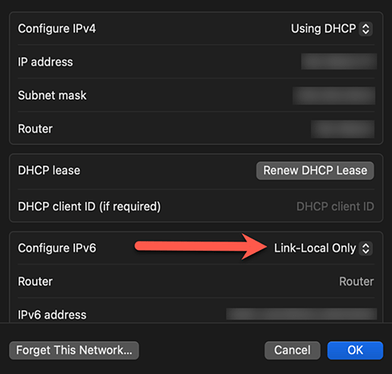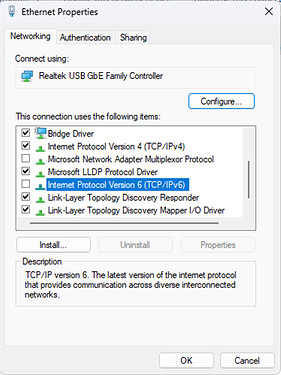Issue
You cannot reach the InvisaGig Configuration Page via its configured IPv4 address (default: ‘https://192.168.225.1’).
Cause
There can be a few different causes for this issue. Each numbered cause below corresponds directly to a numbered resolution:
-
VPN software such as ZeroTier or other commercial VPN clients (ex. NordVPN, Zscaler, Fortinet FortiClient, Cisco AnyConnect, Ivanti Pulse Secure, etc.) may be preventing traffic from reaching the InvisaGig due to the virtual network adapters and routing changes they introduce on your local PC or Mac.
-
Using InvisaGig software v1.0.10 or older in combination with some Ubiquity routers may result in page timeouts due to the router’s inability to negotiate the proper TCP packet sizes to complete the HTTPS connection TLS handshake.
-
The InvisaGig unit is connected to a router supporting multi-WAN configuration (Ubiquity, Firewalla, etc.) or a home router (TP-Link Deco, etc.) that frequently clears cached route information. This issue may be frequently encountered when the default IP Passthrough (Bridge) mode of the InvisaGig is enabled.
-
The InvisaGig is connected to a logical switch port instead of a physical Ethernet interface and the default IP Passthrough (Bridge) mode is enabled.
-
The cellular connection is unstable causing the InvisaGig to ‘flap’ between connected and disconnected network states.
-
Power supplied to the InvisaGig is experiencing drops, fluctuations, or insufficient amperage.
-
The InvisaGig unit is directly connected to a PC or Mac which is forcing IPv6-only connectivity.
-
The web browser you are using may have known issues with rendering the InvisaGig Configuration Page or is otherwise unsupported.
Resolution
-
At least during initial configuration and placement of the InvisaGig, it may be necessary to disable the virtual network adapters installed by your VPN software. If you are using Windows press ‘WinKey + R’ to open a run prompt, enter ‘ncpa.cpl’, then click ‘Ok’ to view the list of network adapters. From this window, right-click on your VPN adapter and choose ‘Disable’. Then open a fresh web browser window to retry your access.


-
Upgrade to InvisaGig v1.0.12. If this is not possible then you may need to set an firewall rule for MSS clamping as detailed in this KBA.
-
Some routers remove or alter routes to the devices that are connected to the WAN ports depending on the model and specific configuration scenario. In most of these cases you will need to set a static interface (a.k.a. “on-link”) route that points to the InvisaGig Configuration Page IP address so that connected LAN clients will always know how to reach the InvisaGig. In some cases, you may need to add accompanying firewall rules which permit LAN clients to access the WAN interface the InvisaGig is connected to.
Refer to the device-specific KBAs below for instructions on how to set a static route on your router so that LAN clients can reach the InvisaGig. If your device model is not mentioned, you may need to reference the router manufacturer’s documentation for detailed instructions on how to set the necessary static route:
https://forum.invisagig.com/t/inability-to-access-the-invisagig-config-page-under-unifi-os-multi-wan-failover-configurations
https://forum.invisagig.com/t/inability-to-access-the-invisagig-config-page-under-edgeos-multi-wan-failover-configurations
https://forum.invisagig.com/t/inability-to-access-the-invisagig-config-page-using-tp-link-deco-mesh-systems
https://forum.invisagig.com/t/inability-to-access-the-invisagig-config-page-using-tp-link-archer-routers -
In general, it is not recommended to connect the InvisaGig to a standalone switch or logical switch port of a router when using the default IP Passthrough (Bridge) mode because this interferes with the automatic MAC addresses detection that is needed to assign the ‘passed-through’ (‘bridged’) IPv4 address when connecting to the cellular provider.
If the unit must be connected to such a port, either the MAC address of the desired WAN interface should be statically specified or IPPT (Bridge) mode should be deactivated on the InvisaGig side. Either of these options is configurable under the ‘Local IP & Multiple Modem Setup’ menu option and requires a restart to take effect. -
In this case, moving the InvisaGig to a location where it receives a stronger cellular signal or away from devices which could be causing interference is the simplest resolution. In extreme cases where the configuration page cannot be accessed at all, it is recommended to deactivate the default IP Passthrough (Bridge) mode of the InvisaGig.
Removing power and the SIM card, then reconnecting power should allow access to the Configuration Page so that you can access the ‘Local IP & Multiple Modem Setup’ option of the Menu in order to disable IPPT/Bridge mode.
After re-inserting the SIM card and rebooting you should now maintain more consistent Configuration Page access needed to assess ‘Live Signal’ outputs for moving the InvisaGig unit to a more suitable location where it will receive a stable signal. -
For indoor InvisaGig installations it is recommended to only use the AC adapter which was originally supplied with the unit (12v, 3A). If the unit is installed outdoors in an antenna enclosure such as the QuadLink and uses Power over Ethernet (PoE) it is important to check the PoE injector and splitter to ensure they are outputting the proper voltages and that the Ethernet cable (Cat. 5e/6/7) carrying data and power between the injector and splitter is using solid copper core conductors and not CCA (copper-clad aluminum) which is incompatible with PoE.
-
For an InvisaGig unit connected to MacOS you will need to enable ‘Link-Local Only’ IPv6 configuration on your Ethernet adapter:
For Windows, at least temporarily you may need to disable the IPv6 binding from the Ethernet adapter:
-
Officially supported browsers include desktop versions of Chrome, Brave, Edge, and Safari. Other browsers such as Firefox may load the Configuration Page without issue but may not support all functionality such as User Profile Import. Mobile browser versions on phones and tablets are known to work in most cases but are not officially supported due to potential scaling and rendering issues inherent in touchscreen devices.

